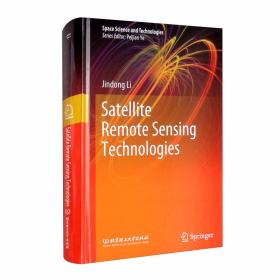
卫星遥感技术
¥ 69.17 4.4折 ¥ 158 全新
库存5件
天津津南
认证卖家担保交易快速发货售后保障
作者Jindong Li 编
出版社北京理工大学出版社
出版时间2020-09
版次1
印数1千册
装帧精装
上书时间2024-05-16
- 最新上架
商品详情
- 品相描述:全新
图书标准信息
- 作者 Jindong Li 编
- 出版社 北京理工大学出版社
- 出版时间 2020-09
- 版次 1
- ISBN 9787568290647
- 定价 158.00元
- 装帧 精装
- 开本 16开
- 纸张 胶版纸
- 页数 421页
- 【内容简介】
- 《卫星遥感技术》是北京理工大学出版社与Springer Nature联合出版图书。卫星遥感技术作为一门综合性的科学技术应用于政治、经济、军事和社会等众多领域,具有视域广、数据采集快、可重复并连续观测等特点,在国土资源的监测和开发、交通设施监测、灾区重建、农林业资源调查等方面具有不可替代的作用。该书主要阐述了各类遥感卫星系统的设计、遥感卫星任务分析、技术特点,内容涉及高分辨率合成孔径雷达遥感卫星系统设计、遥感卫星系统构建与总体构型布局设计、高速图像数据处理与传输系统设计、遥感卫星微振动抑制与在轨检测技术、遥感卫星总装集成与验证技术等10章。该书原创性强、创新性突出,反映了作者及其团队在卫星遥感领域科学研究和工程实践取得的新方法、新技术与新成果,主要为从事遥感卫星总体设计、卫星数据采集与分析及有关专业的科技人员和政府决策人员提供智力支持。
- 【作者简介】
-
Prof.Dr.Jindong Li,doctoral supervisor and expert in the field of aerospace remote sensmg,currently works in Beijing Institute of Spacecraft System Engineering in China Academy of Space Technology as a chief designer in a certain area.Professor Li mainly engaged in the overall design of remote sensing satellites and research on spacecraft thermal control technology,and has successively served as the chief designer of several remote sensing satellites,a project expert in Major Basic Research on National Security,the chief scientist for National Defense 973 Program,and a member of Russian Academy of Cosmonautics by K.E.Tsiolkovsky.He has won 3 second prizes of the National Science and Technology Progress Award,4 first prizes,1 second prize,and 2 third prizes of the National Defense Science and Technology Award,and has published more than 80 academic papers in domestic and foreign journals and
important academic conferences. - 【目录】
-
1 Fundamentals of Satellite Remote Sensing Technology
1.1 Introduction
1.2 Physical Basis of Satellite Remote Sensing
1.2.1 Electromagnetic Wave and Electromagnetic Spectrum
1.2.2 Solar Radiation Characteristics
1.2.3 Interaction Between Solar Radiation and Atmosphere
1.2.4 Interaction Between Electromagnetic Radiation and Target
1.3 Terrestrial Environment
1.3.1 Analysis of Satellite On-Orbit Environment and Effect
1.3.2 Charged Particle Radiation Environment
1.3.3 Vacuum
1.3.4 Neutral Atmosphere
1.3.5 Solar Electromagnetic Radiation
1.3.6 Solar Disturbance
1.3.7 Total Dose Effect of Space Radiation
1.3.8 Spatial Displacement Effect
1.3.9 Spatial Single Event Effect
1.4 Introduction to Satellite Remote Sensing Engineering System
Reference
2 Space Orbit Design of Remote Sensing Satellite
2.1 Overview
2.1.1 Classification by Orbit Altitude
2.1.2 Classification by Orbital Characteristics
2.2 Design Requirements and Characteristics of Remote Sensing Satellite Orbits
2.2.1 Orbit Design Analysis of Optical Remote Sensing Satellite
2.2.2 Orbit Design Analysis of Microwave Remote Sensing Satellite
2.3 Analysis and Design of Multi-mission Orbits for Optical Remote Sensing Satellite
2.3.1 Orbit Selection Principle
2.3.2 Satellite Multi-mission Orbit Design
2.3.3 Design of Satellite Multi-mission Orbit Parameters
2.3.4 Orbit Control
2.3.5 Orbit Control Fuel Consumption
2.3.6 Mission Application Strategy
2.3.7 Design of Initial Orbit Offset
2.3.8 Drift Characteristics of LTDN
2.3.9 Design of Resolution and Revisit Ability
2.4 Orbital Analysis and Design of Microwave Imaging Remote Sensing Satellite
2.4.1 Orbit Selection Principle
2.4.2 Orbital Parameter Determination
2.4.3 Mission Orbit Parameter
2.4.4 Initial Orbit Offset Design
2.4.5 Orbit Control
2.4.6 Observational Capability Analysis
2.4.7 LTDN Drift
3 Analysis and Design of High-Resolution Visible Spectral Remote Sensing Satellite System
3.1 Overview
3.1.1 Development Overview
3.1.2 Trend of Development
3.2 Demand Analysis and Technical Characteristics
3.2.1 Demand Analysis
3.2.2 Technical Characteristics of Visible Spectral Remote Sensing Satellite
3.3 Key Performance Indicators of Imaging Quality of Visible Spectral Remote Sensing System
3.3.1 Radiation Imaging Quality
3.3.2 Geometric Imaging Quality
3.4 Analysis and Design of Imaging Quality of High-Resolution Visible Spectral Camera
3.4.1 Overview of the Development of High-Resolution Visible Spectral Cameras
3.4.2 Key Design Elements of Visible Spectral Camera
3.4.3 Design of GSD and Camera Focal Length
……
4 Design and Analysis of Infrared Remote Sensing Statellite System
5 Design and Analysis of Hyperspectral Remote Sensing Statellite System
6 Design and Analysis of High-Precision Stereo Surveying and Mapping Satellite System
7 Design and Analysis of High-Resolution SAR Remote Sensing Satellite System
8 Design and Analysis of High-Precision Microwave Remote Sensing Satellite System
9 Design and Analysis of Optical Remote Sensing Satellite System on Geostationary Orbit
10 Development Prospect
点击展开
点击收起
相关推荐
— 没有更多了 —















以下为对购买帮助不大的评价